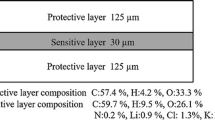Abstract
Although there are several two-dimensional (2D) dose-distribution measurement methods using proton beam therapy, they all have drawbacks; hence, there is no standard method established worldwide. The purpose of this study was to develop a simple, high-precision 2D distribution measurement method for proton beam therapy that uses an imaging plate and EBT3. First, we expanded the maximum readable dose (saturation dose) in the imaging plate. The method involves (i) the control of the fading phenomenon by an annealing process and (ii) the control of the photostimulated luminescence (PSL) phenomenon using a longpass filter (LPF). In method (i), upon heating at 80 °C, the PSL became 0.485 times the room temperature, and in method (ii), we attenuated the PSL by a factor of 0.245 using an LPF. Thus, by combining methods (i) and (ii), we expanded the saturation dose to 2 Gy. Thus, it was possible to measure the imaging plate and EBT3 in the same dose range. We simultaneously measured the percent depth dose using imaging plate and EBT3. We defined a correction factor to match the measured values—which had a reduced sensitivity because of the linear energy transfer (LET) dependence of the imaging plate and EBT3—with reference data and developed a correction factor function. Subsequently, by defining the relative LET dependence of imaging plate and EBT3 as the relative sensitivity and converting the relationship imaging plate between the relative sensitivity and correction factor into a function, we obtained a sensitivity-correction function. By employing this function, measurements with the same accuracy as the reference data were performed using the imaging plate and EBT3.












Similar content being viewed by others
References
Das IJ, Chen CW, Watts RJ et al (2008) Accelerator beam data commissioning equipment and procedures: report of the TG-106 of the Therapy Physics Committee of the AAPM. Med Phys 35:4186–4215
Ajomandy B, Sahoo N, Ding X et al (2008) Use of a two-dimensional ionization chamber array for proton therapy beam quality assurance. Med Phys 35:3889–3894
Zhao L, Das IJ (2010) Gafchromic EBT film dosimetry in proton beams. Phys Med Biol 55:N291–N301
Martisíková M, Jäkel O (2010) Gafchromic EBT films for ion dosimetry. Radiat Meas 45:1268–1270
Ajomandy B, Tailor R, Anand A et al (2010) Energy dependence and dose response of Gafchromic EBT2 film over a wide range of photon, electron, and proton beam energies. Med Phys 37:1942–1947
Angellier G, Gautier M, Herault J (2011) Radiochromic EBT2 film dosimetry for low-energy protontherapy. Med Phys 38:6171–6177
Mumot M, Mytsin GV, Molokanov AG et al (2009) The comparison of doses measured by radiochromic films and semiconductor detector in a 175 MeV proton beam. Physica Med 25:105–110
Park SA, Kwak JW, Yoon MG et al (2011) Dose verification of proton beam therapy using the Gafchromic EBT film. Radiat Meas 46:717–721
Nohtomi A, Terunuma T, Kohno R et al (1999) Response characteristics of an imaging plate to clinical. Nucl Instrum Methods Phys Res A424:569–574
Nohtomi A, Sakae T, Terunuma T et al (2003) Measurement of depth-dose distribution of protons. Nucl Instrum Methods Phys Res A511:382–387
Ito M, Amemiya Y (1991) X-ray energy dependence and uniformity of an imaging plate detector. Nucl Instrum Methods Phys Res A310:369–372
Fujibuchi T, Tanabe Y, Sakae T et al (2011) Feasibility study on using imaging plates to estimate thermal neutron fluence in neutron-gamma mixed fields. Radiat Prot Dosim 147:394–400
Amemiya Y (1995) Imaging plates for use with synchrotron radiation. J Synchrotron Radiat 2:12–21
Ohuchi H, Yamadera A (2002) Dependence of fading patterns of photo-stimulated luminescence from imaging plates on radiation, energy, and image reader. Nucl Instrum Methods Phys Res A490:573–582
Amemiya Y, Miyahara J (1988) Imaging plate illuminates many fields. Nature 336:89–90
Author information
Authors and Affiliations
Corresponding author
Rights and permissions
About this article
Cite this article
Mori, Y., Isobe, T., Yamaguchi, Y. et al. Development of simple high-precision two-dimensional dose-distribution measurement method for proton beam therapy using imaging plate and EBT3. Australas Phys Eng Sci Med 39, 687–696 (2016). https://doi.org/10.1007/s13246-016-0464-8
Received:
Accepted:
Published:
Issue Date:
DOI: https://doi.org/10.1007/s13246-016-0464-8




